Memoriam

Clive Goddard, PCO Chair writes:
The Professional Cartoonists’ Organisation are shocked and saddened to hear of the death of the London Cartoon Museum’s Alison Brown.
Aged just 39, Alison was the museum’s retail and front of house manager as well as assisting with exhibitions and being the face of many public events. She was a passionate advocate for cartoons and comic art and an instantly likeable person, popular with everyone who met her.
Having been admitted to hospital in December with a pelvic infection she had undergone surgery and transferred to a rehab ward where she remained in good spirits. Tragically, she then contracted Covid 19 which, due to her weakened state, she was unable to fight off.
Our deepest sympathies go out to Alison’s family and friends.
Here’s another tribute to Alison by The Cartoon Museum Director Joe Sullivan: The Museums Association
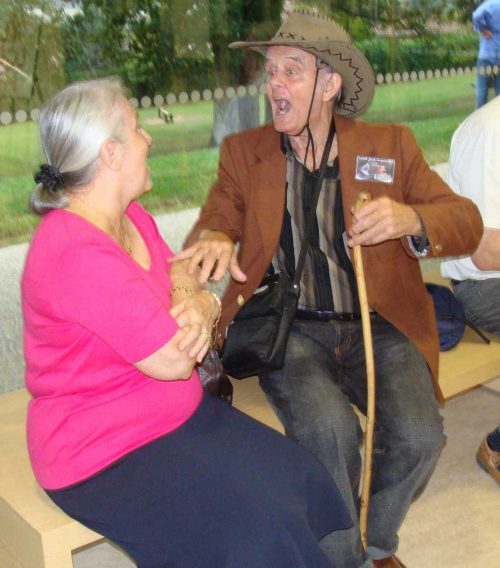
Alex Noel Watson, renaissance man and raconteur
Terry Anderson writes:
The Professional Cartoonists’ Organisation is saddened to learn of the death of veteran cartoonist Alex Noel Watson.
Born in Airdrie in 1929 Watson was a true renaissance man. As well as a cartoonist he worked as a film critic, travel writer, storyboard artist and book jacket designer. His cartoons appeared in publications too numerous to mention but most notably the Daily Express, Daily Star, Evening Standard, New York Times, Private Eye, Punch, Spectator, Sunday Times, Telegraph, Toronto Star and – a particular point of pride – The New Yorker.
Like many I only got to know the man in the last coupe of decades as he began making regular trips to the Salon International de la Caricature, du Dessin de Presse at d’Humour in Saint-Just-le-Martel. Watson was one of the festival’s most effusive supporters, writing enthusiastically about it for the PCO’s blog as well as The Jester, the magazine of The Cartoonists’ Club of Great Britain.
With his bushman hat and walking stick he cut a distinctive figure, always to be found holding court with tall tales of his former exploits. A polyglot, he was very comfortable mixing with colleagues from around the world although he never made any concessions to accent – as far as I could tell his French was grammatically perfect but always spoken like a man from Lanarkshire rather than Limoges.
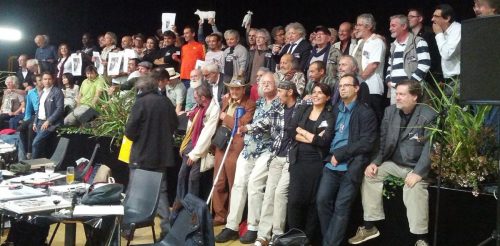
Alex takes centre stage at Saint-Just-le-Martel
One could hardly mention one of the world’s great cities without Watson being able to tell you about something that happened to him there in his youth. It became a little bit of a game for me to see if there was any conversational topic that he couldn’t stake a claim to. So while standing by the medieval church in Saint-Just I regaled a small group with the story of the Alien gargoyle to be found on my hometown of Paisley’s historic abbey, a curiosity which had become an internet sensation after it was spotted by an American tourist. Having quietly taken it all in he replied “Yes, very interesting. Of course, I used to draw storyboards for Ridley Scott…” I conceded defeat.
That was 2013, which I believe was the last time he made it to France having actually postponed a surgical operation in order to attend. No longer able to travel in his last few years some of my fellow cartoonists would make a point of visiting his home in Surrey to keep him up to date on all that was happening.
His passing will no doubt come as a blow to long-time members of the CCGB and PCO as well as the good people of Saint-Just-le-Martel who have lost far too many of their friends in recent years.
The PCO send our condolences to his wife Milenka who we understand is not in the best of health and so has asked that those who knew Alex refrain from making contact until circumstances have improved.
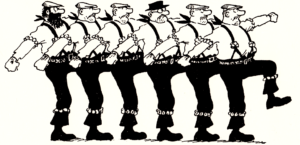
Drawing of ‘The Cloggies’ from Bill’s long running Private Eye strip.
Bill Tidy (1933-2023) – A Tribute
Rupert Besley writes:
It’s funny what sticks in the memory. First kiss, first day at new school, first pint, first dive into a pool… To which I’d add, first sight of a Bill Tidy cartoon.
1965. We’d just moved house and my brother came home with a small book of cartoons (‘Sporting Chance’ I think it was, pubd 1961) by a Bill Tidy. Inside, the author explained that in his search for work he had had to abandon his original name: approaching newspapers with a card that read Will Tidy had got him only as far as the Office Cleaning Dept.
The book fell open on a cartoon of a prison football match. As the home team rammed the ball into the back of the net, a roar went up from the crowd behind. ‘GAOL!’ Then as now, that seemed brilliantly funny, as with so many others that followed in all the years since.
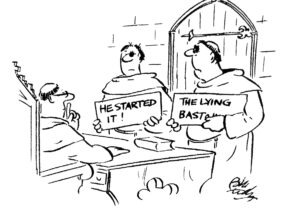
Cartoon from ‘Private Eye – A Cartoon History‘
Bill Tidy cartoons were so very different from the bland, lame gags, tired and predictable, that were to be found in abundance around. His stood out for their freshness and originality. And, for the time, they were pretty outrageous too (see his contributions to Private Eyewash, pubd 1968, and what he did with Wash & Brush Up in the Gents for 2/-). His busy mind clearly revelled in the bizarre and absurd, from dim mafiosi to minor royalty from Middle Europe competing for precedence at state funerals. Then there was the Chinese Emperor berating the workforce at the foot of a huge stone sphere: ‘Great Wall, I said, not Ball’ (or words to that effect). And the humour wasn’t just in the ideas, so gloriously daft and distinctive, but in the execution too. His gifts for rapid drawing, expressive faces, captions, dialect, dialogue and animated scenes in which unlikely bodies hurtled through air, brought smiles to any viewer, long before the joke was got.
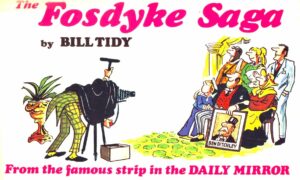
Fosdyke Saga book cover c.1971
Quickfire, zany, Liverpudlian, off the wall – call it what you will, Bill Tidy’s humour took cartooning to new heights, and kept this up in his long-running strips like Cloggies and the Fosdyke Saga. And there were so many others he immortalised: tripe magnates, real ale buffs, Scottish World Cup football fans, the scientists of Grimbledon Down… Small wonder that he was so much in demand on tv and radio – for decades he must have been the only cartoonist that the general public could ever put a voice or face to.
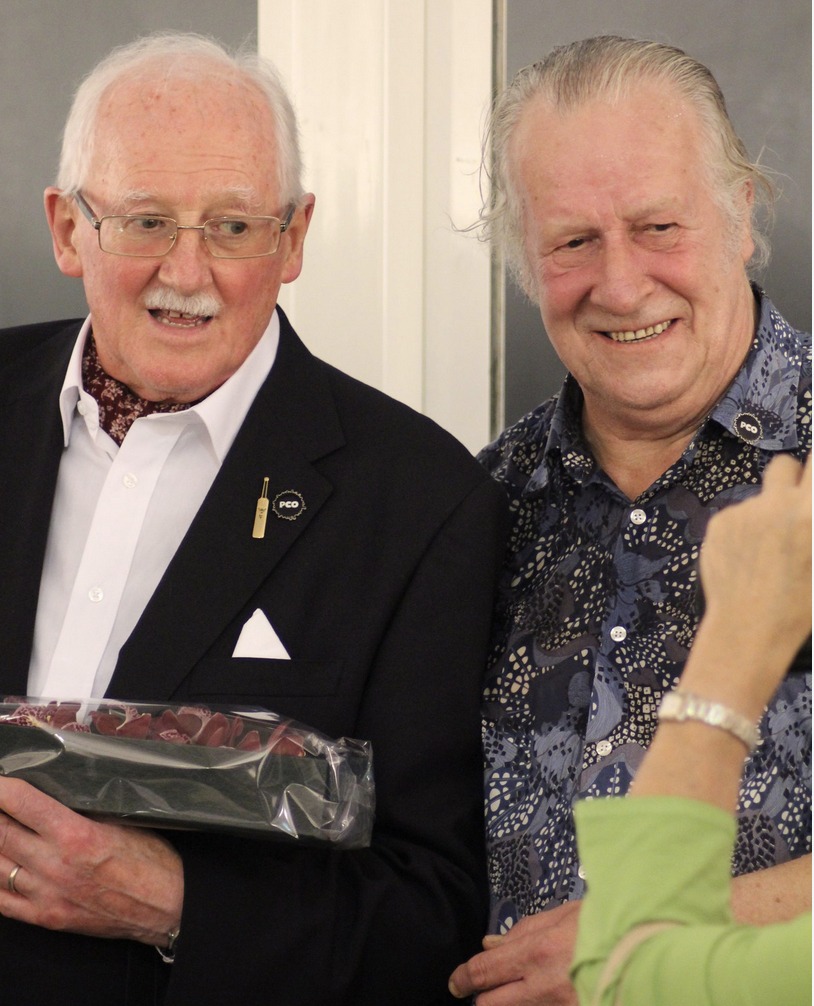
Bill sporting a PCO badge with former PCO ‘Chairleg’ Bill Stott, Photo by Rob Doyle kindly supplied by Chris Williams.
Bill Tidy didn’t just raise the bar in cartooning; he did much for the profession besides. He was a founder member of the Cartoonists’ Club of Great Britain and of the British Cartoonists’ Association, as well as patron from the start of the Professional Cartoonists’ Organisation. It was just a sadness that the work he put into trying to rescue Punch in its hour of need all came to nothing. What stayed on, though, was an apparently inexhaustible fount of good humour, still reaching for pen and paper in hospital as he came round from his first stroke.
Self-taught, supremely gifted and an inspiration to so many, Bill Tidy remains a cartooning legend. I’ll end with a quote or two from colleagues who have been sharing such thoughts.
It was a collection of Tidy’s that I stumbled on in the late 90s which first inspired me to try gag cartooning, an area of cartooning I’d not been overly interested in before. Perhaps Tidy’s stuff showed me just how good gag cartooning could be, and/or his breadth of subject matter made me realise with the gag cartoon you can go anywhere in time and space – Wilbur Dawbarn.
Superb draughtsman, wit and quick with it too. I look back with a warm glow to my late school and early art student days when I used to look forward every week for the next cartoon-packed edition of Punch to come out.
Along with others, they would regularly feature a Tidy double page spread (about a dozen gags) on a particular, quirky news topic (unheard of exposure in today’s market) and Bill’s imagination would run riot. This was the early 70’s and along with Hector Breeze, Honeysett, Mike Williams, Albert, Larry, Pyne, ffolkes, Lowry, Heath, David Myers and others, Bill Tidy’s brilliant and prolific creations led the way in that golden age of gag cartooning – Pete Dredge.
Brilliant cartoonist, great character, and lovely man – Steve Bright.
The PCO is sad to report that David Hawker, a Punch regular, passed away at St. Michael’s Hospice, Basingstoke on 31st August.
David first contributed to Punch in 1967 and his easy drawing style betrayed an acerbic wit, as the accompanying cartoon demonstrates.
More of David’s wonderful work can be found in the Punch galleries here.
David is survived by his sister.
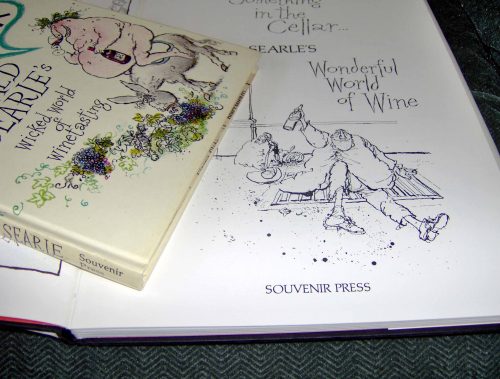
Loss of a good friend to cartooning…
Loss of a good friend to cartooning and to football, politics, theatre, health and much else besides. Ernest Hecht, whose Guardian obituary can be reached by the link below, has died at 88.
Rupert Besley writes:
In 1951 EH founded The Souvenir Press and remained its managing director and driving force for the next 65 years and more. As an independent publisher with an eye for mischief and a competitive streak, EH relished the thrill of chasing down those he admired across an extraordinarily wide field of interest. He was literary agent to Pelé and then to the whole Brazilian football team. And he was first to get the Beatles in print. Che Guevara was one of his authors, along with Civil Rights campaigners and five Nobel Prize Laureates – and none of that stopped him publishing ‘Le Petomane’ (star farter at the Moulin Rouge) or ‘an absorbing history of toilet paper’. Matt Busby, Albert Einstein, Ken Dodd, The Dalai Lama…the word ‘eclectic’ might have been invented for Ernest Hecht.
Football was an abiding love. He got to nine of the last eleven World Cup championships – and wore his Arsenal scarf and cap to the Palace when he went to collect the OBE presented to the ever-generous Hecht for a lifetime of charitable giving and philanthropy.
Publishing (and culture) in postwar Britain was transformed by a group of remarkable individuals, all of whom had arrived in this country in flight from Nazi persecution of Jews: George Weidenfeld, André Deutsch, Paul Hamlyn… Ernest Hecht was the last of that group. He reached Britain, unaccompanied, on the Kindertransport in 1939. It was the end of a long and difficult journey that began with him and his mother travelling to Prague by rail from their home in Czechoslovakia. (His parents later made it to the UK.) The only other occupant of the compartment was a Gestapo officer. The young Ernest, never good on trains, was promptly sick over the officer’s uniform. By good fortune for Mrs Hecht, petrified in that moment, the officer was himself a parent with some understanding.
A witty man, Ernest Hecht had a real enjoyment of humour and this was reflected in his publication list containing cartoon books by the likes of Hoffnung and Calman. From John Donegan he got three cartoon books, deliciously titled ‘Dog Almighty’, ‘Dog Help Us’ and ‘For Dog’s Sake!’ But the star name was Ronald Searle, five of whose books he published over 30 years. For these alone, cartoon-lovers everywhere will always have good reason for thanks to Ernest Hecht.
Frank Dickens © Martin Reidl
The PCO is sad to report that Frank Dickens, the creator of the much loved comic strip “Bristow”, has died aged 84.
“Bristow” was initially rejected by every national newspaper and first appeared in the regionals. The Evening Standard decided to take it in 1962 and it went on to be syndicated worldwide, except in the US, where Dickens rejected suggestions that his characters should be Americanised.
According to The Guinness Book of World Records it became the longest-running daily cartoon strip by a single author.
Bristow © Frank Dickens
However Dickens’s greatest success, in financial terms at least, came through the syndication in the US of another strip entitled “Albert Herbert Hawkins: The Naughtiest Boy in the World”, even though it was banned from some American school libraries for advocating “defiance of adult authority by showing misbehavior for which the protagonist goes unpunished”.
An interesting technical side note is that Dickens is said to have invented the device whereby the words of the action (“tap, tap”; “flick, flick” etc) appear beside the character. He claimed it came about due to his inability to draw expression and movement well enough.
Albert Herbert Hawkins © Frank Dickens
Dickens also wrote several children’s books (one of which was illustrated by Ralph Steadman) and had work adapted for stage and radio. He also wrote two thrillers centred around the world of cycle racing, something he knew a great deal about, having moved to Paris after doing his National Service, hoping to compete in the Tour de France but failing to qualify…
His obituary in The Daily Telegraph (see link below) tells of a life lived and a penchant for disrobing at inappropriate moments. Dickens’s marriage, to Maria del Sagrario, ended in divorce after 13 years, he recalled, because “when she learnt to speak English she realised she didn’t like me.” Their daughter survives him.
Frank Dickens, born December 9 1931, died July 8 2016
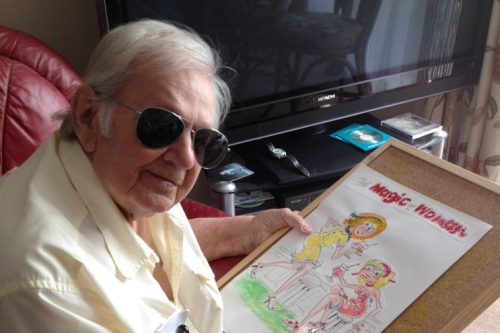
Fred Jefferies
Andrew Birch writes:
This is to announce the sad news of the death of PCO member Fred Jefferies, at the grand old age of 89.
Fred was born in Paddington and attended St Martin’s Art College, becoming a freelance cartoonist shortly afterwards. He recently published two books of fun and lively cartoons, Love Bites (2015) and Love is…Small Talk (2016), despite being registered blind in 2001. An extraordinary and inspirational achievement.
Our sympathy goes out to Fred’s family and friends.
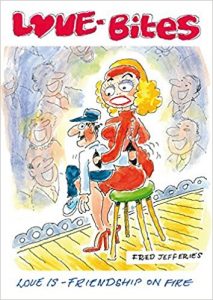
© Fred Jefferies Estate
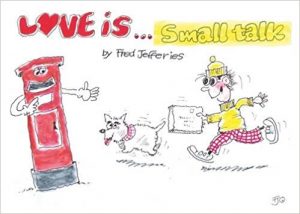
© Fred Jefferies Estate
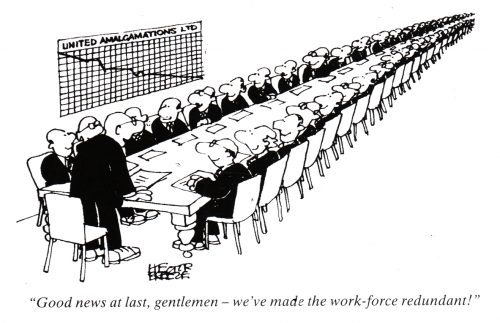
Cartoon from Private Eye – A Cartoon History
Rupert Besley writes:
The sad news of the passing of Hector Breeze not long after celebrating his 90th birthday, has, unsurprisingly, brought in a flood of tributes from fellow cartoonists, all recognising the greatness of the man along with the warmth, charm and wit of his cartoons. Hero, wonderful, great, favourite, brilliant, classic, prolific… are words piling up on the PCO forum from the pens of Pete Dredge, Noel Ford, Roger Penwill, Mike Turner, Neil Dishington, Andrew Birch, Glenn Marshall – and expect more to come as the news spreads.
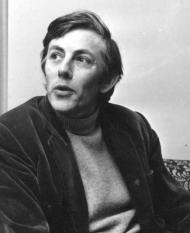
Hector Breeze
Hector Breeze developed what was surely the perfect cartooning style for the kind of pocket-sized gags he churned out so prolifically and successfully over so many years (since the late 50s). With their robust lines, economy of detail and strong use of solid blacks, HB cartoons were instantly recognisable as his and stood out a mile off as funny. Central to them were his stock characters, ever charming, ever bewildered. Tramps, army chaplains, oddballs, kings. You had to warm to them.
‘Gentle humour’ is a damning phrase, usually coded for ‘not funny’. Hector Breeze cartoons were never savage or angry, but they were funny. Damned funny.
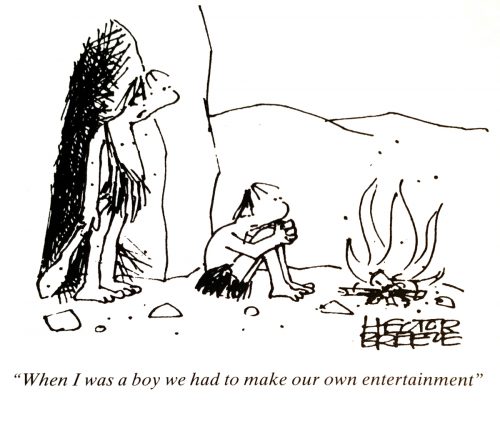
Private Eye cartoon
He sold his first cartoon to Melody Maker in 1957 and over the following five decades and more, Hector Breeze cartoons brought sheer enjoyment to national publications that included Private Eye, Punch, the Evening Standard, the Mirror, Sketch, Guardian and Express. Having begun in a government drawing office, he later worked in advertising. Among his other skills (no surprise from the clarity of his signature) was letter-carving in stone.
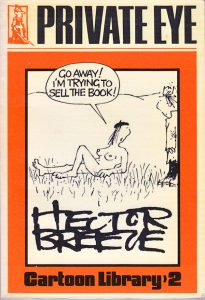
A collection of Hector’s work produced by Private Eye in 1973
As with Sprod, it took me some while to discover that Hector Breeze was his real name and not something dreamt up as pen-name (he couldn’t have hit on better if he had tried).
In 2011 the PCO Blog team put together a piece on the Top Ten of Cartoonists’ Favourite Cartoonists. Pete Dredge’s choice was Hector Breeze, illustrated with a perfect gag and summed up exactly right:
‘Out of the mouths of his mundane, benign, chunkily drawn characters comes the sharpest of captions.’
In 1996 Ralph Steadman wrote that Breeze’s “clumsy bewildered characters restore my faith in the seriously daft.”*
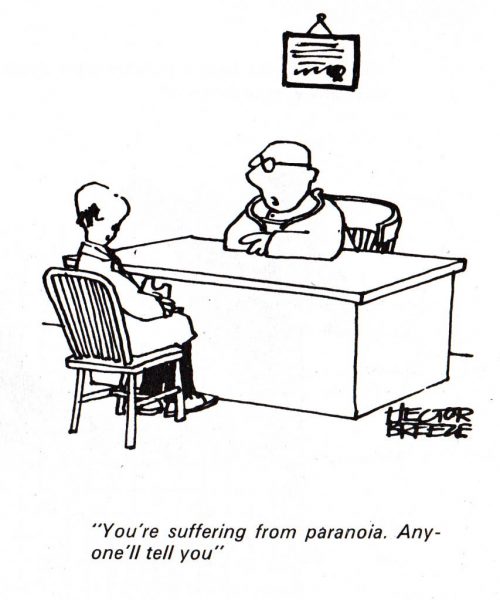
Cartoon from the Hector Breeze Private Eye Cartoon Library
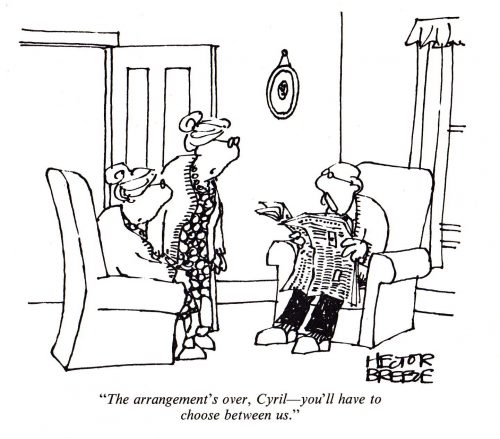
From Pick of Punch, 1973
Our thoughts are with Hector’s family.
*Quote and photo courtesy of The British Cartoon Archive
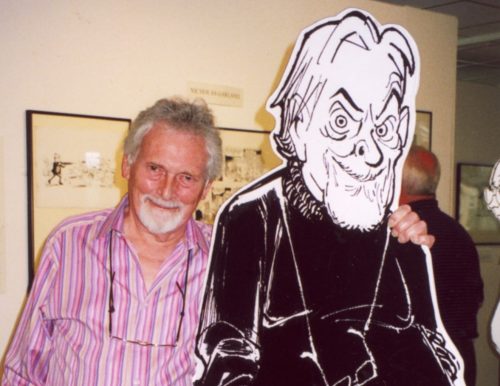
John with a ‘selfie’ which he did for an exhibition at the cartoon archive, Kent University. Photo © Pat Jensen
Sadly, it has been reported that John Jensen has passed away at the sprightly age of 88. John was a well respected and fondly thought of member of the cartoon community. He was a supreme and very versatile draughtsman.
John was born in Sydney in 1930, the son of the cartoonist Jack Gibson (he took his stepfather’s surname in the 40’s) In 1946 he studied at the Julian Ashton Art School, Sydney. His first cartoon was published in the Sydney Sun in 1946, and he then began contributing cartoons to various Australian publications.
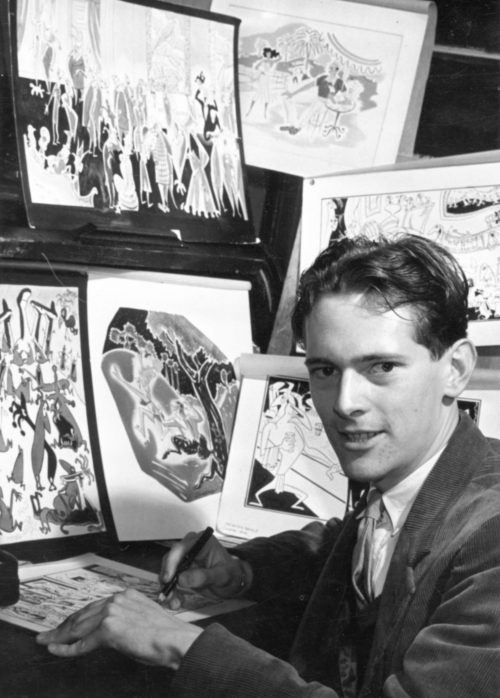
John in Birmingham, 1953, Photo © Pat Jensen
In 1950 John worked his way to England on a cargo ship, and briefly became an actors’ dresser at London’s Piccadilly Theatre, before becoming a cartoonist full-time. From 1951 to 1956 he drew cartoons, caricatures and illustrations for the Birmingham Gazette and then for various publications in Glasgow including Scotnews, The Glasgow Bulletin and daily pocket cartoons for the Glasgow Evening Times.
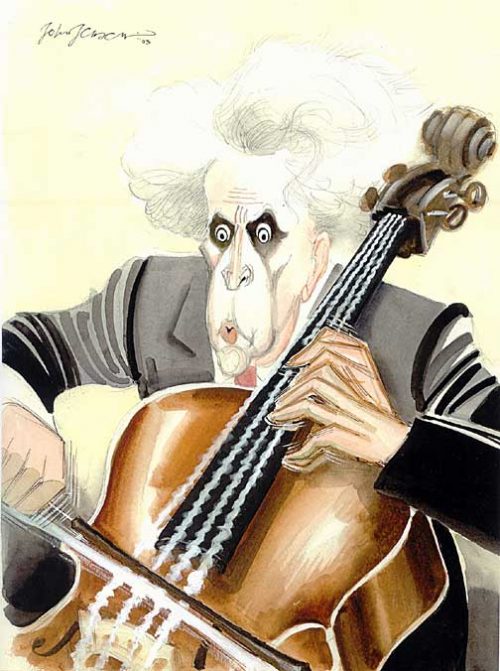
Illustration of French cellist Paul Tortelier, © John Jensen
John had his first cartoon in Punch magazine in 1953 but became a Punch regular in the 70’s, prolifically drawing cartoons, illustrations and caricatures. He writes here about his memories of Punch.
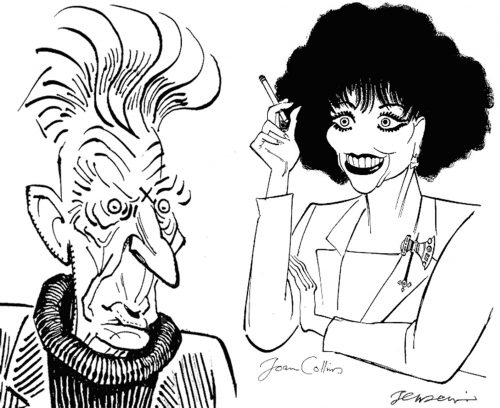
Caricatures of Samuel Beckett & Joan Collins © John Jensen
He was also the theatre caricaturist for Tatler, and social cartoonist for The Spectator. He drew a strip for the short-lived Now magazine and on top of this he was the political cartoonist for The Sunday Telegraph from 1961-79 (he was one of the very first political cartoonists to work in colour.) Over this long career John has illustrated around 70 books.
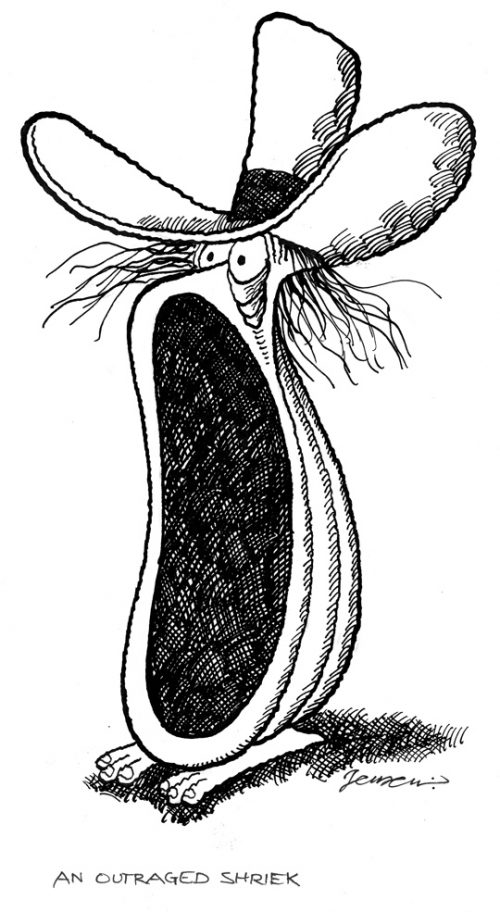
From his ‘Figures of Speech’ collection © John Jensen
John was a founder member and Chairman of the British Cartoonists’ Association, and of the Cartoon Art Trust. In 2002 he was given a ‘Grinny’ Lifetime Achievement Award from the Nottingham Cartoon Festival. During his time as a member of the PCO he regularly wrote for and featured on this blog.
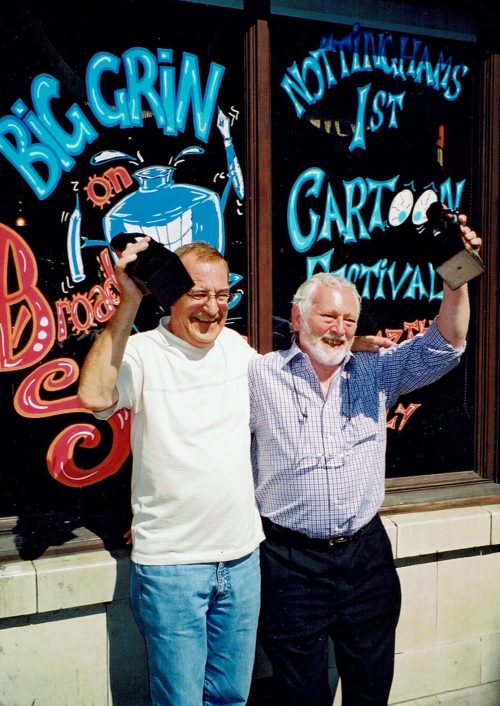
Receiving his ‘Grinny’ award (pictured with Dave Follows), Photo © Pete Dredge
John was a regular at cartoon festivals and on one trip to New York ended up at the celebration dinner where Marylin Monroe sang ‘Happy Birthday Mr President’ to JFK. On a visit to Cuba in the 60’s he also endured one of Castro’s extremely long speeches.
Among the many anecdotes circulating about John over the past week I particularly enjoyed this one from the wonderful cartoonist Kevin ‘Kal’ Kallaugher:
‘Back in the 1980’s while I was still living un the UK I had arranged to meet John for a pint one lunchtime. When he arrived to the pub, I noted that he had a brace on one of his wrist which made his hand quite incapacitated. I was immediately concerned that this might be his drawing hand and that the brace might have consequences on his freelance career. When I raised this question with him, he shrugged it off.
“I just draw with the other hand” he said.
When I pursued this further I learned to my astonishment that John used both hands to draw his cartoons. He explained that each hand had a personality. His left hand (as I recall) was the imaginative, loose artistic hand and his right hand was the more technical and exacting hand. He would often do his conceptual sketches with the left and finish off the art with his right. Later he showed me samples of his cartoons that had contrasting styles which he explained was due to the amount of time one hand spent rendering over the other.
Soon afterwards, I wrote an article for a scholarly US cartoon related periodical called Target, where I interviewed John pointed out his amazing bi-manual drafting skills and displayed his work. Throughout the exercise, John was characteristically polite and kind…but still really did not quite see what all the fuss was about. This after all seemed quite ordinary to him.
This may have been ordinary to him, but to me John Jensen and his cartoons will always remain extra-ordinary’.
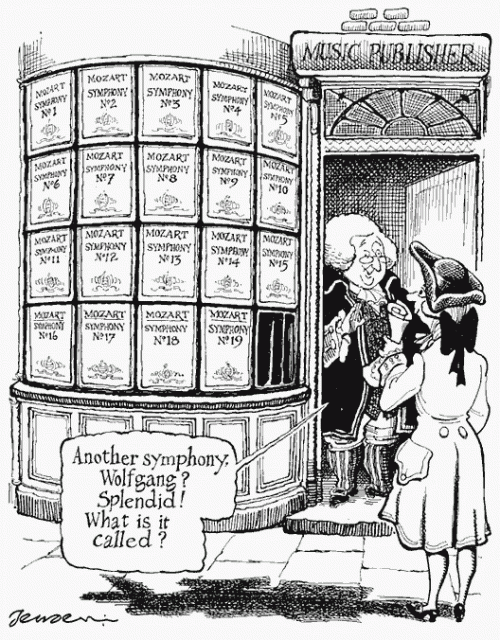
Mozart cartoon © John Jensen
More of John’s work can be found on his website.
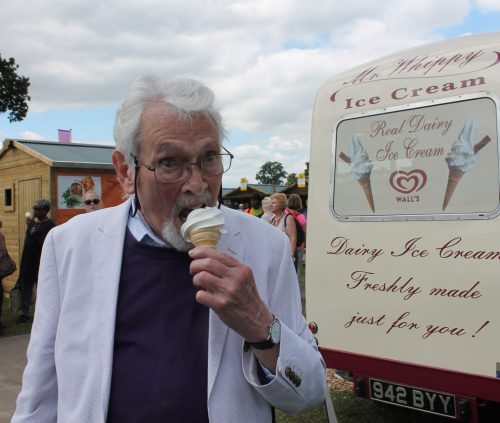
A favourite family memory of John is how he could never resist an ice cream © Pat Jensen
Our sympathies go to John’s wife Pat and his family and friends.
I’m indebted to the British Cartoon Archive for much of the biographical detail.
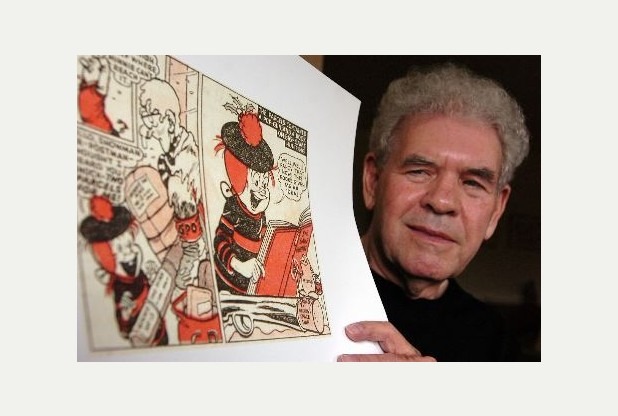
The adjective ‘legendary’, bestowed too cheaply upon too many, finds a truly worthy recipient in the man who brought utter joy to generations of British children with his brilliant creations, Minnie the Minx and the Bash Street Kids.
Leo Baxendale’s wonderfully inventive comic strips drew the reader into a world where anything was possible and everything rib-achingly funny. His anarchic humour chimed with children of all ages and the vibrant penmanship inspired countless comics artists.
The hit list included other classic strips Little Plum, The Three Bears and Lord Snooty. The comics historian Denis Gifford has called him “the most influential and most imitated comics artist of modern times”.
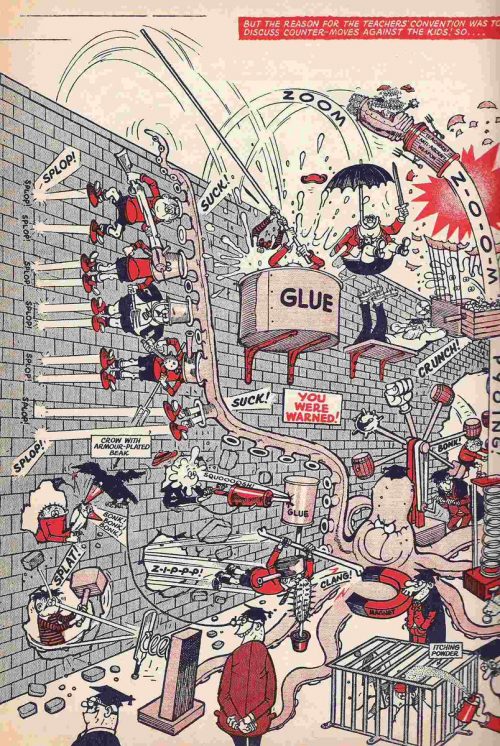
The pressure of unrelenting deadlines took its toll on Baxendale and in 1962 he walked out on DC Thompson (a seven year legal rights battle with the Beano publisher was to follow) and found work two years later with Wham! and Smash! comics in London.
Less well known, perhaps, was his involvement in the activist newsletter the Strategic Commentary, campaigning against the US’s involvement in the Vietnam war. Noam Chomsky was his first subscriber.
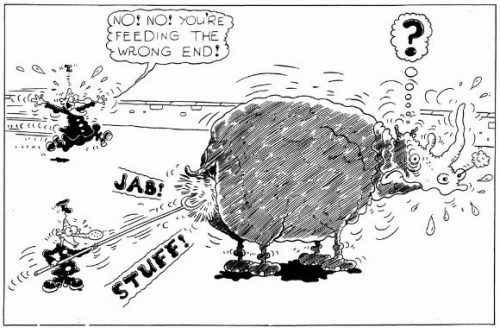
Baxendale also founded the publishing house Reaper Books in the late eighties and continued to work in comics before retiring in 1992 to concentrate on publishing books. He was inducted into the British Comic Awards Hall of Fame in 2013.
He died from cancer on Tuesday 25th April.
Read James Heartfield’s obituary here on the spiked website.

Martin Honeysett 20 May 1943 – 20 January 2015
Martin’s funeral took place on a wet, windy Friday 13th in Hastings, attended by several PCO members and significant folk from his publishing past, including Richard Ingrams, Tony Rushton and Martin Rowson. The crematorium was packed to the rafters – a powerful appreciation of a man who was loved for his personal qualities as much for his brilliant, wicked cartoons. His wicker coffin sat there, adorned only with one of his famous hats.
Among the many generous tributes were reminiscences from his lovely daughter Sophie, Tony Rushton of Private Eye and others – but perhaps the most memorable reading came from an old friend, Bob Mazzer. a well-known local photographer. He has known Martin for decades, and recalls that they had an instant sense of connection when they first met. This is perhaps not surprising – like Martin, Bob is an unassuming, self-effacing genius. In recognition of Martin’s incarnation as a London bus driver, he read the following:
The Bus Driver’s Prayer
Our Father, who art in Hendon,
Harrow Road be thy name.
Thy Kingston come,
Thy Wimbledon
In Erith as it is in Hendon.
Give us this day our Berkhampstead
And forgive us our Westminsters,
As we forgive those who Westminster against us.
Lead us not into Temple Station,
And deliver us from Ealing.
For thine is the Kingston,
The Purley and the Crawley,
For Iver and Iver,
Crouch End.
It was a fitting tribute in a ceremony which was poignant, moving and funny. Martin would have approved.
© Michael Crawford
So close to the passing of Frank Dickens, the PCO is sad to report the loss of another member of the cartooning family: Michael Crawford.
Fellow New Yorker cartoonist, Peter Steiner, commented: “When Michael Crawford died, we lost an interesting and gifted artist”.
Another, Joe Dator, said: “Mr. Crawford had an absurd space-cadet sense of humor that I always admired.”
Condolences to friends and family of this wonderful cartoonist.
More tributes from New Yorker cartoonists can be read here on Michael Maslin’s Inkspill site.
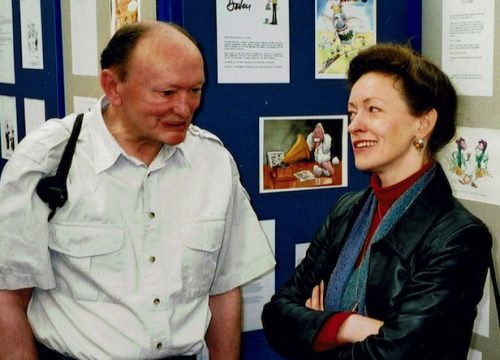
Mike and Anita O’Brien at Ayr Cartoon Festival
Pete Dredge writes:
Like many cartoonists of a certain age, I first met Mike in the late 1970’s through membership of the Cartoonists’ Club of Great Britain. In those days the Club would meet monthly in The Cartoonist Pub in London’s Shoe Lane, as well as regularly arranging various “out of town” weekend, brewery-sponsored jaunts and an annual 5 day convention at Butlins. Mike, being one of the most sociable of chaps you’d ever wish to meet, was in his element. Nothing cliquey about Mike, he would find the time to talk to anyone and everyone in the room. This of course was no mean feat and Mike would usually sustain this time-consuming endeavour with a pint of best bitter and pin-sharp wit to hand.
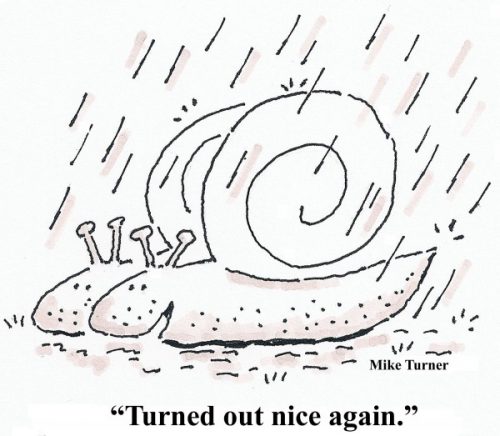
Mike was a slightly built Mancunian but had the constitution of an ox and would often be found propping up the bar into the wee small hours as others fell pathetically by the wayside. I have only twice gone 24 hours without sleep and both times were in Mike’s wonderful, mischievous company. The first was on the CCGB’s 1979 trip to New York and, more recently, at the Ayr Cartoon Festival in 2001.
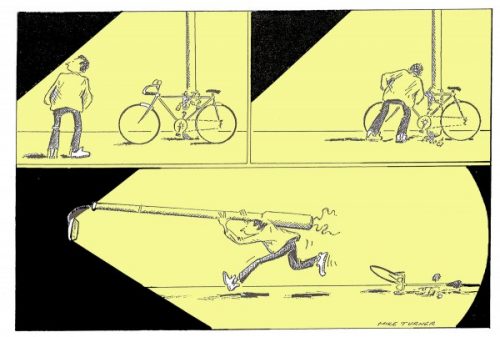
Sadly Mike contracted prostate cancer about 7 years ago and this put paid to his legendary imbibing and although his treatment appeared to be successful the cancer returned a few months ago with devastating effect . I last saw Mike about 3 years ago but spoke to him regularly on the phone over the years. Latterly the usual ‘mock bewilderment ‘ conversations about the machinations of cartoon editors was gradually replaced by more serious discussions of a medical nature.
Mike was a great gag cartoonist (Private Eye, The Spectator, The Oldie etc) who should have graced the pages of magazines much more frequently than he did. He served the CCGB well, not only as a lifelong member but as a distinguished chairman and put great store on the importance of the newsletter as a means of keeping distant, more remote members in touch with what was going on. As well as being a member of the PCO, Mike was also a member and regular attendee of BCA dinners.
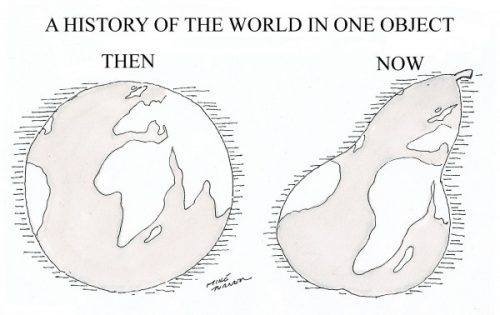
Mike and joyous laughter (seasoned with a hint of cynicism) were synonymous and I, and all his colleagues will miss him greatly.
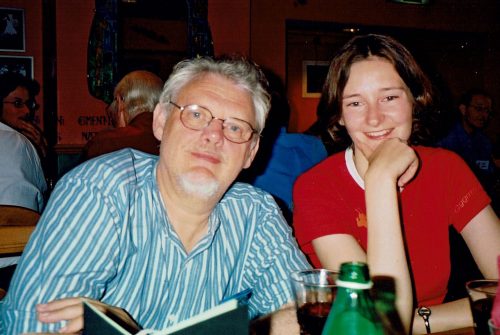
Noel with daughter Sara at Nottingham’s Big Grin Cartoon Festival 2003. Photo © Pete Dredge
Pete Dredge writes:
It’s a cruel irony that it is only when someone passes that the outpourings of love, praise and acknowledgement spill out from friends, colleagues and acquaintances. Such has been the response to the sudden and unexpected death of ace cartoonist and one of the founders of PCO, Noel Ford , who died on September 27th after a cruel return of the kidney cancer that was first diagnosed two years previously.
I suspect Noel would have been, on the one hand, hugely embarrassed, but on the other, quietly delighted by the tributes that have been pouring in on the forums and social media, not only for his cartooning skills but also to the nature of the man.
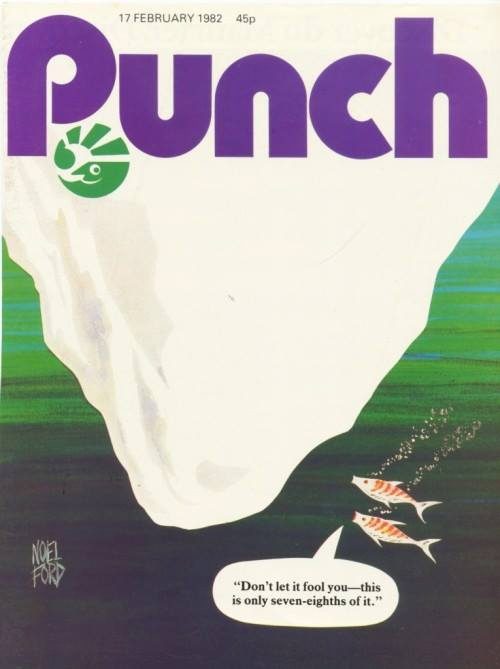
One of Noel’s many Punch covers.
Noel was a modest chap, never one to blow his own trumpet but was someone who would go about his business with the supreme confidence of knowing that he was, and had been for many years, on the top of his game. His game, of course, was cartooning, particularly gag cartooning and, at his peak, was producing double page spreads and covers for Punch magazine with audacious regularity.
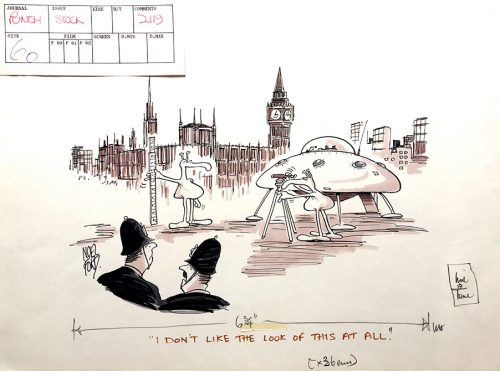
Punch original from the recent ‘London Cartoon Show’ exhibition.
It’s pointless listing Noel’s professional credits, there are far too many to mention, but one of his many gifts was his ability to rally, organise and deliver cartooning projects. A professional cat herder, if ever there was one. I’ve seen Noel’s patient diplomacy, wisdom and common sense work effectively at close hand on many occasions when others’ egos, intransigence and misconceptions – no names! – would lock horns and all it would take was a few choice words from Noel to smooth over troubled waters. Such was the respect that his fellow professionals had for him. Take Noel out of the equation and many of these initiatives would never have seen the light of day.
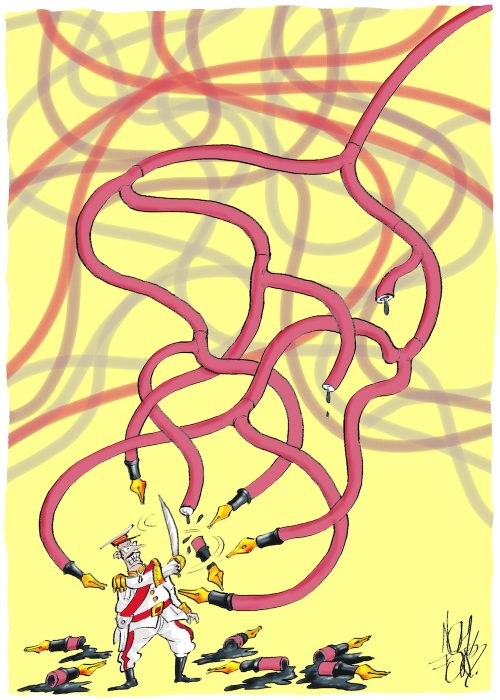
A digital drawing for the PCO ‘GAGGED’ censorship exhibition currently on display at Saint-Just-le-Martel cartoon festival.
The Cartoonists’ Guild, College of Cartoon Art and, most successfully, the PCO had all benefitted hugely from Noel’s vision, perseverance and professionalism. Add to this his invaluable committee work on the Shrewsbury Cartoon Festival and The cartoonists’ Club of Great Britain, Noel certainly put in much more than he took out from these extra-curricular calls of duty.
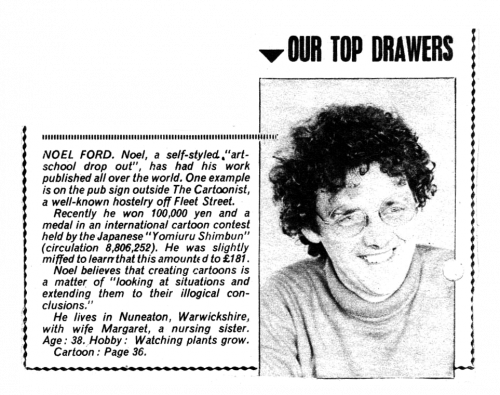
Clipping from ’80s magazine, either Weekend or Tit Bits (via Davey Jones)
Noel was born in Nuneaton on 22 December 1942 and apparently displayed early signs of his future calling, drawing cartoons in chalk on the pavement outside the front door of the Ford family house. After leaving school it was at the Birmingham College of Arts and Crafts where Noel received the oft repeated advice we have all probably received, to “forget about any ambitions of becoming a cartoonist. You’ll never make a living that way”. The rest is Noel Ford cartooning history. Sadly, today, that lazy, dismissive piece of advice is probably more pertinent that it would have been in the 1960’s and 70’s. More’s the pity that today the markets for showcasing Noel’s and other’s superb gag cartoon craft have all but disappeared.
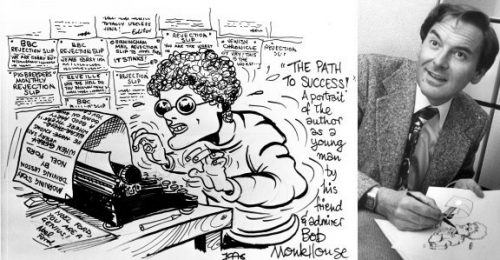
Caricature of Noel by Bob Monkhouse and a picture of Bob drawing it (via Royston Robertson)
Noel was irritatingly multi-talented. Not only was he a superb draughtsman, he was also a gifted musician, writer and an early pioneer of the digital art platform as well as being a fine exponent of the Argentine Tango (check this.Ed).
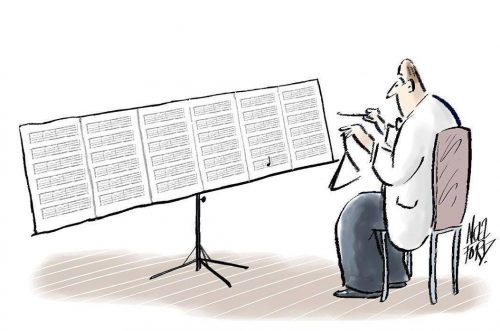
Cartoon from the exhibition at the ‘Music’ themed Shrewsbury International Cartoon Festival 2014.
It has to be said, Noel enjoyed the good things in life. Good food, fine wine, a good book, comradeship, country living, dogs and, above all, the love of his family and friends.
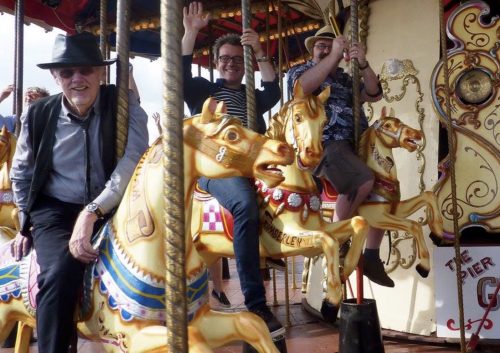
Noel demonstrating his equestrian skills at Herne Bay Cartoon Festival 2017. Photo © Karol Steele
I’ll miss his mischievous twinkle and Muttley-like chuckle when something, invariably, would tickle his proverbial fancy.
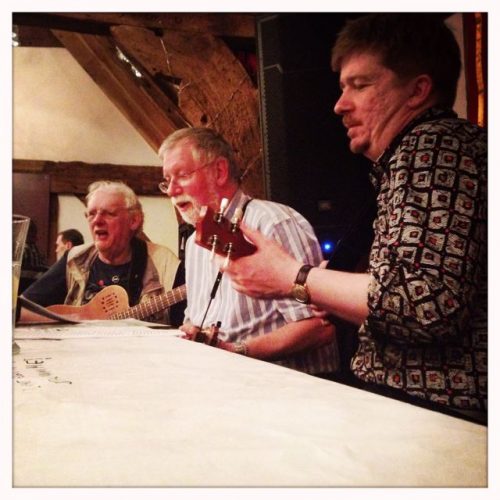
Noel at one of the Shrewsbury Cartoon Festival ukulele-thons. Photo ©The Surreal McCoy
With deepest sympathy to Margaret, Sara and family from all your friends at PCO.

All at PCO were shocked and saddened to hear of the death of Tony Husband, one of the cartoon world’s all time greats.
There have already been numerous fine tributes written about Tony – here’s a great memoriam by John Freeman on Down The Tubes comics-related blog. Another excellent testimonial with wonderful photos and video links can be found on the Greater Mancunians site. The BBC also marked his passing.
For our own tribute, we asked our members to share some of their favourite cartoons from the ‘Husband’ archive. What better legacy could Tony have left but his joyous body of work.
Here are some of our individual selections.
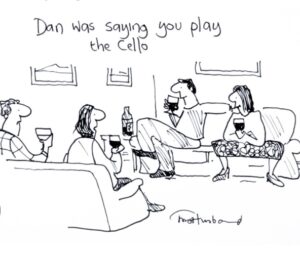
Kathryn Lamb:
There are so many wonderful Tony Husband cartoons to choose from, but I’ve chosen this one (above). Apart from being effortlessly funny and genuinely laugh out loud, his cartoons were often touching and showed his humanity and understanding of human nature.

Steve Jones (Jonesy):
Trying to pick a favourite Tony Husband cartoon is nigh on impossible. However I’ve gone with this one (as will many others I’m sure), not just because it’s so funny but for the absolute truth of it.
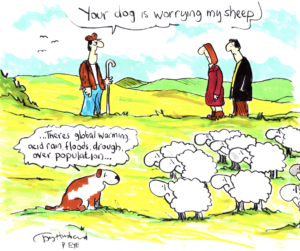
Steve Bright (Brighty):
I really don’t want to say why I like it more than any other of Tony’s prolific and wonderful cartoons. Probably because I’ll no doubt then find one I haven’t seen that marginally eclipses it. But in any case, I don’t think my words can do anything but get in the way of every reason I love this cartoon. It’s surely obvious? So, just enjoy it, and then go and find some more and choose your own. There are few better ways to spend the day.
Not only did Steve pick a cartoon but he also did this wonderful caricature of Tony below (Blog Ed)
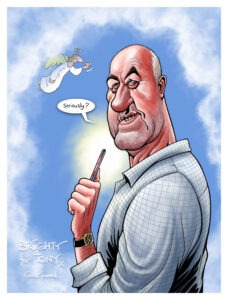
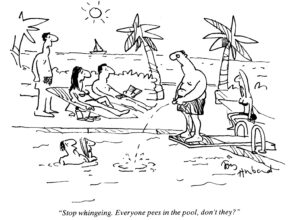
Nick Newman:
There are so many of Tony’s gags to choose from – but I particularly loved this when it first appeared in the Eye. So much so that I acquired the original. It’s classic Husband – black humour, slightly surreal and yet grounded in reality. And very very funny.

Cathy Simpson:
It’s terribly difficult to pick out one cartoon from someone with such a prolific output, but I’m picking the rather dark one above. I was also a huge fan of Martin Honeysett, who I think would have approved of this choice!
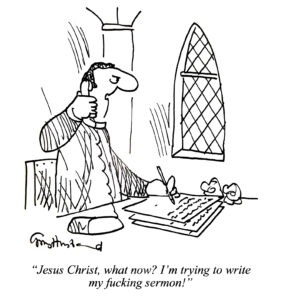
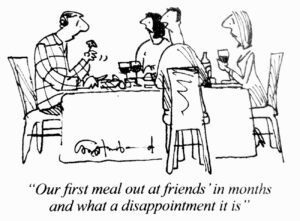
The good thing about doing this with Tony’s back catalogue is there are just so many wonderful gags to choose from. I’d maybe go for the famous molehills spelling “f$*k off” or this one I managed to track down in a back issue of Private Eye from shortly after the end of the first lockdown in July 2020. The pathos!
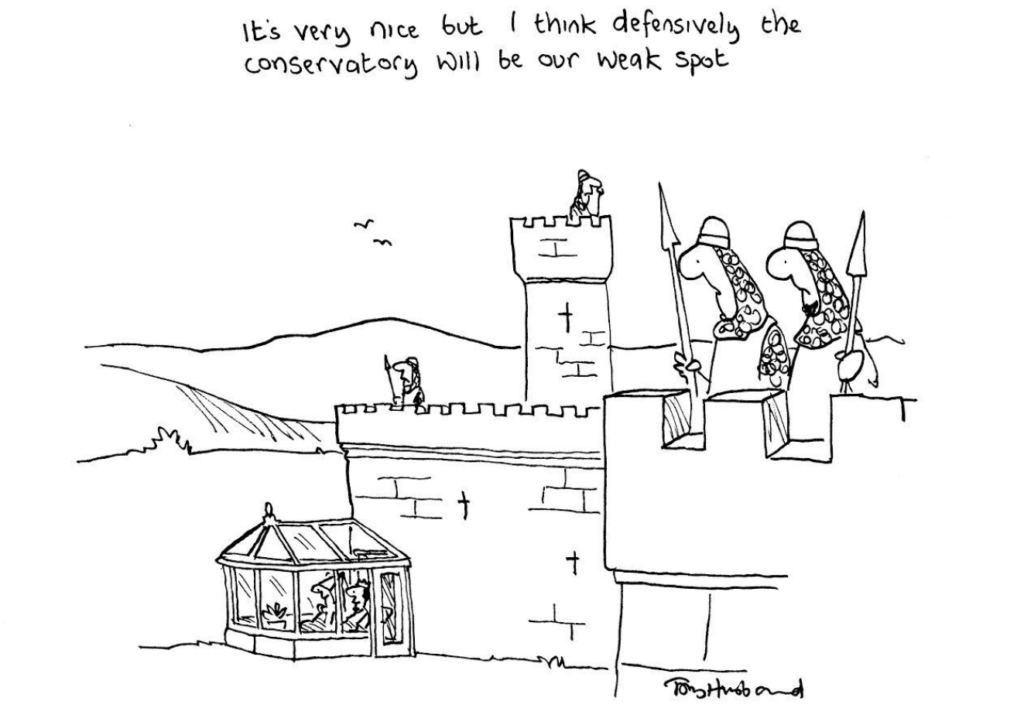
Andrew Fraser (Drew):
My favorite and also the favourite of some others on social media. Not only is it a fantastic gag but the scene is so well constructed.

Clive Goddard:
Hard to pick a favourite so whittled my shortlist down to ‘Trying to grow a beard’, ‘She can test my eyesight anytime’, I’ve sorted out the problem with the neighbours’ but will go for ‘Dogs who look like their owners competition.’ just because of its beautiful simplicity and daftness. Tony had a style which looked effortless and having seen him draw live in Shrewsbury probably was for him. This is a perfect example of a visual gag which you don’t spot immediately and have to revisit because the image is so bloody funny.
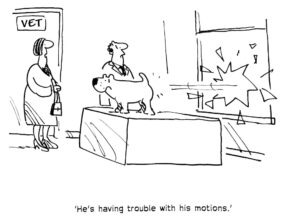

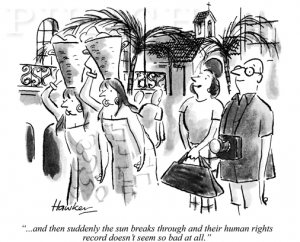
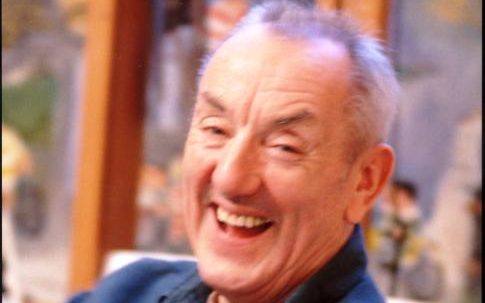

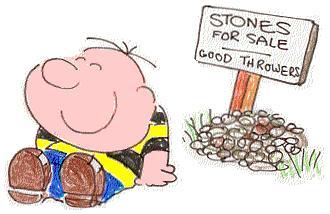
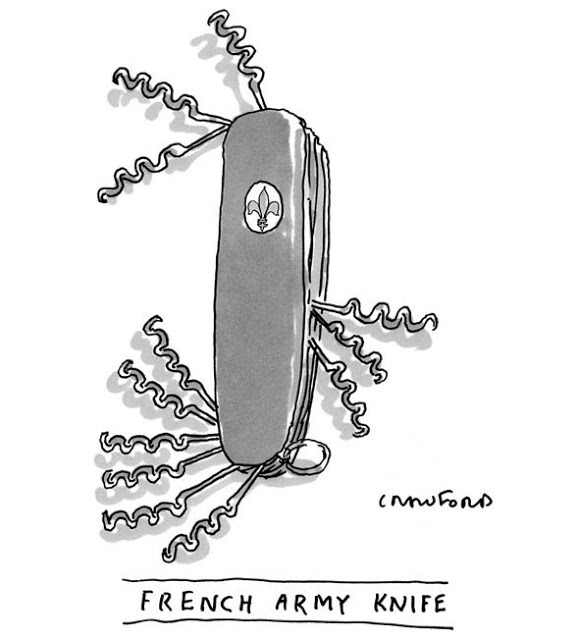
Rupert Besley:
Cartoons come in every kind, but often it is the simplest (of idea and of execution) that carry the strongest punch. Simple, but far from easy to do. Tony had that rare ability and had it to perfection. He could churn out classic gags, so wittily drawn, that were instantly, riotously and outrageously funny – and are so still each time you see them. Pure cartooning genius.
Chris Williams (Dink):
I’m completely failing to find a copy of one of my favourite Tony Husband gags. It involves a dinner party, a man bent over and an irate wife saying something like “Perhaps John and Sandra don’t want to know about your piles Martin!” You can picture it yourselves. That’s my level.
Also while looking for it I had a brief trawl through the Cartoonist Club of Great Britain archive of The Jester magazine and spotted a few gags Tony had done for it in the early 80s. All cartoonist related so I thought I’d post them here for you as you won’t see them anywhere else I think.
Pete Dredge:
I too have had trouble tracking down my favourite so I’ve drawn it from memory. The subject matter is particularly poignant but I think Tony would appreciate it.
Tony was a massive influence in my early cartooning days, His humour was powerful, effortless and always funny… I will remember him as the rock n’ roll cartoonist, Mr Cool, his work will live on forever… RIP Tony
This cartoon attached is a magnificent feast of jokes, taking the piss out of us load of sad, grumpy, old nerds… (well I speak for myself!)
Sadly I was looking forward to seeing him at the Private Eye boat party on the River Thames, on the day he died… Everyone at Private Eye is devastated, and the manner in which it all unfolded and his text to Nick Newman, very poignant, a very sad day.
Dean Patterson (deAn):
It’s an odd thing to think there will a British cartooning industry without Tony Husband in it. For me, I think I will miss Yobs the most. The first cartoon I turn to in the Eye and then a constant companion as I spend two weeks trying to get about 80% of the crossword done. Even after looking at it for two weeks, it’s always still made me chuckle.
Jeremy Banx:
Ben Chilton:
Very touching to see all the tributes to Tony. Oink and Round the Bend were a big part of my childhood and Private Eye remains a big part of my adulthood. I never met him myself but the love and respect from those who knew him says it all. RIP
James Mellor:
I love the fact that the gag is so simple but it also makes you do a bit of a double take, which was the hallmark of so many of his cartoons. I only met Tony in person once, but he sent me many kind words and I will miss the encouragement.
Wilbur Dawbarn:
I’ll plump for this one, because, er… it’s bloody funny!
Glenn Marshall:
As others have said it’s almost impossible to choose one cartoon. So I’m cheating by including a whole books’ worth, but the one on the cover is a favourite of mine from this indeed darkly comic collection.
We’ve all gone for great gags by Tony but he also had a lot of humanity and as well as making you laugh out loud he could equally bring a tear to your eye. I found this particularly poignant cartoon he’d posted on his twitter feed. Also, his very moving book on his Father’s dementia helped many who were dealing with similar issues.
This was Tony being interviewed on ITV News earlier this year, when he had an exhibition of his work in Oldham. He talked about his dementia campaigning work and about the very heart rending cartoon he drew on the migrant boat crossings.
Our sincere condolences to Tony’s family and friends.
RIP Tony